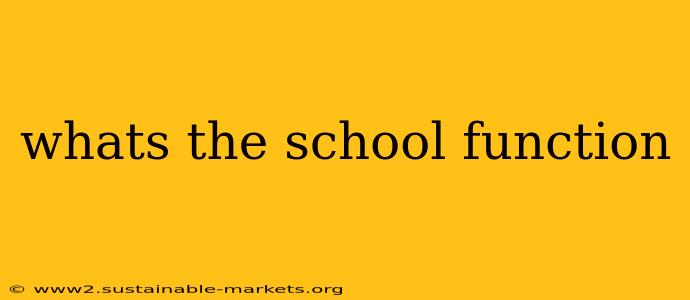Understanding School Functions: Beyond the Bell
The term "school function" is broad, encompassing a wide range of activities designed to achieve the overall educational goals of a school. It's not simply about classes and homework; it's about the entire ecosystem that fosters learning and development. Let's break down the multifaceted nature of school functions:
Core Educational Functions:
-
Teaching and Learning: This is the fundamental function. It involves delivering curriculum, assessing student understanding, and providing individualized support. Effective teaching methods, engaging curriculum, and appropriate assessment strategies are crucial here. This function also encompasses different learning styles and needs, catering to diverse learners through differentiated instruction.
-
Curriculum Development and Implementation: Schools constantly evolve their curriculum to meet changing educational standards and student needs. This involves selecting appropriate textbooks, designing lesson plans, and evaluating the effectiveness of the curriculum in achieving its learning objectives.
-
Student Assessment and Evaluation: Measuring student progress is paramount. Schools use various assessment methods, including formative and summative assessments, to track individual student growth and identify areas needing improvement. This data informs teaching practices and helps guide student support services.
Supporting Functions:
-
Student Support Services: These services extend beyond academics, focusing on the holistic development of each student. Examples include counseling, special education support, tutoring, and extracurricular activities. These functions are vital for creating a supportive learning environment that addresses students’ emotional, social, and physical well-being.
-
Administration and Management: The smooth operation of a school depends on effective administration. This includes managing finances, staffing, facilities, and legal compliance. This function ensures the school runs efficiently and provides the necessary resources for teaching and learning.
-
Community Engagement: A successful school fosters strong ties with the wider community. This involves engaging parents, local businesses, and community organizations to enhance the educational experience. Parent-teacher associations, community outreach programs, and volunteer initiatives are examples of this function.
Extracurricular Functions:
-
Co-curricular Activities: These activities complement the curriculum, enriching student learning and development. Examples include sports, clubs, arts programs, and student government. These functions contribute significantly to student well-being and provide opportunities for leadership, teamwork, and skill development.
-
School Events and Celebrations: Functions like school plays, concerts, graduations, and assemblies bring the school community together, celebrating achievements and fostering school spirit. These events build a sense of belonging and contribute to a positive school culture.
The Interconnectedness of School Functions:
It's essential to understand that these functions are interconnected and interdependent. Effective teaching relies on well-developed curricula and supportive administrative structures. Student success depends on both academic instruction and robust support services. The overall success of a school is a direct result of how well all these functions work together. Understanding these interconnected components offers a more complete picture of what makes a school function effectively.

